Hrodna State University
| Гродзенскі дзяржаўны ўніверсітэт імя Янкі Купалы | |
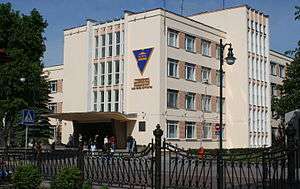 | |
| Motto | Качественное образование, научные исследования, современные технологии – во благо личности, общества и государства |
|---|---|
Motto in English | High-quality education, research, modern technologies - for good of a person, society and nation. |
| Type | Public |
| Established | February 22, 1940 |
| Rector | Yauheni Rouba |
| Students | 17,900 |
| Location | Hrodna, Belarus |
| Campus | Urban |
| Website | www.grsu.by |
Yanka Kupala State University of Grodno (Belarusian: Гродзенскі дзяржаўны універсітэт імя Янкі Купалы, Russian: Гродненский государственный университет имени Янки Купалы) а higher education institution, located in Grodno. It is the largest regional higher education institution in the Republic of Belarus, university complex integrating all levels of education.
In 2011 it was the first university, among higher education institutions of the country, which became the winner of the national contest "Prize of the Government of the Republic of Belarus for achievements in quality".[1][2][3]
In 2011 the Yanka Kupala State University of Grodno received the status of scientific organization.[4]
In 2010 the Yanka Kupala State University of Grodno was the first university, among the regional universities of Belarus, which received national and international certificates of quality management system meeting the requirements of STB ISO 9001-2009 and ISO 9001:2008 (series of standards ISO 9000) [5][6]
According to the international Webometrics ranking (July 2011), YKSUG ranks second among Belarusian universities and 3103 among 12 000 world universities.[7]
It is the second (after BSU) education institution in the Republic of Belarus where the system of electronic student identification card was introduced.
Rectors of the Yanka Kupala State University of Grodno
- Samuil Raskin (1940)
- Dementy Kardash (1940-1941)
- Nikolai Vlasovets (1944-1949)
- Josef Malyukevich (1949-1955)
- Dmitry Markovsky (1955-1973)
- Alexander Bodakov (1973-1994)
- Leonid Kivach (1994-1997)
- Sergey Maskevich (1997-2005)
- Yauheni Rouba (since 2005)
- Andrei Korol (since 2013)


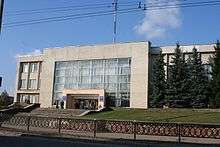
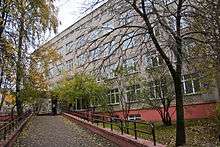
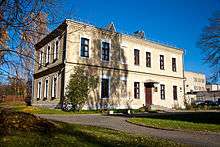
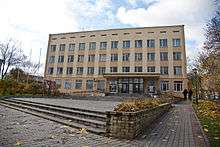

History
On February 22, 1940 by the decision of the Council of People's Commissars of the BSSR Teachers' Training Institute was founded in Grodno. It ceased its development because of the Great Patriotic War. Already in 1944 the studies continued, and the Teachers' Institute was reorganized into a pedagogical (with three Faculties – Physics and Mathematics, Faculty of Literature and Foreign languages Faculty). In 1957 the Institute was honored with the name of Yanka Kupala. In 1967 the first defence of doctoral thesis took place in the Institute, and in 1969 postgraduate studies were introduced. On May 1, 1978 Pedagogical Institute was reorganized into the Yanka Kupala State University of Grodno. September 1, 2010 - introduction of the electronic student identification cards system.
The University today
At present there are: 17 098 students, 284 master students, 162 post-graduate students, 40 professors, 261 associate professors and 316 candidates of sciences. The university comprises 17 faculties and 79 departments.[8] The university research library has more than 700 000 books.[9]
Faculties
- Faculty of Biology and Ecology
- Military Faculty
- Faculty of Arts and Design
- Faculty of History and Sociology
- Faculty of Mathematics and Information Science
- Faculty of Pedagogy
- Faculty of Psychology
- Faculty of Tourism and Service
- Faculty of Physics and Engineering
- Faculty of Physical Training
- Faculty of Philology
- Faculty of Economics and Management
- Faculty of Law
- Faculty of Engineering and Construction
- Faculty of Innovative Mechanic Engineering
- Association of Socio-Humanitarian Departments
- Faculty of Professional skills upgrading and retraining «School of Tourism and Hospitality»
In addition, the University comprises the Regional Centre for Testing and Youth Career Orientation, the Institute for Professional Skills Upgrading and Retraining and colleges:
Logotype of the university and faculties
The logotype of the university and faculties is a stylized letter “У” of the Cyrillic alphabet with certain symbols in the centre.[14]
Alumni
- Olga Korbut – sportsman
- Alaksandar Milinkievič – politician.
Photos
- Yanka Kupala State University of Grodno, Grodno








References
- ↑ Yanka Kupala State University of Grodno has been awarded the Prize of the Government of the Republic of Belarus for quality achievements
- ↑ Yanka Kupala State University of Grodno has been awarded the Prize of the Government of the Republic of Belarus for quality achievements
- ↑ The Prize of the Government of the Republic of Belarus for quality achievements - prize winners 2010
- ↑ Yanka Kupala State University of Grodno underwent accreditation as a scientific organization
- ↑ The quality is guaranteed
- ↑ Yanka Kupala State University of Grodno has been issued the certificate according to which the University meets the standards of the management system
- ↑ Ranking Web by Country: Rank of Universities of Belarus
- ↑ Site map | Yanka Kupala State University of Grodno
- ↑ University research library
- ↑ Volkovysk College Site
- ↑ Humanitarian College Site
- ↑ СTechnological college Site
- ↑ Lida College Site
- ↑ Site map | Yanka Kupala State University of Grodno
Official site
Coordinates: 53°41′00″N 23°50′10″E / 53.6833°N 23.8362°E